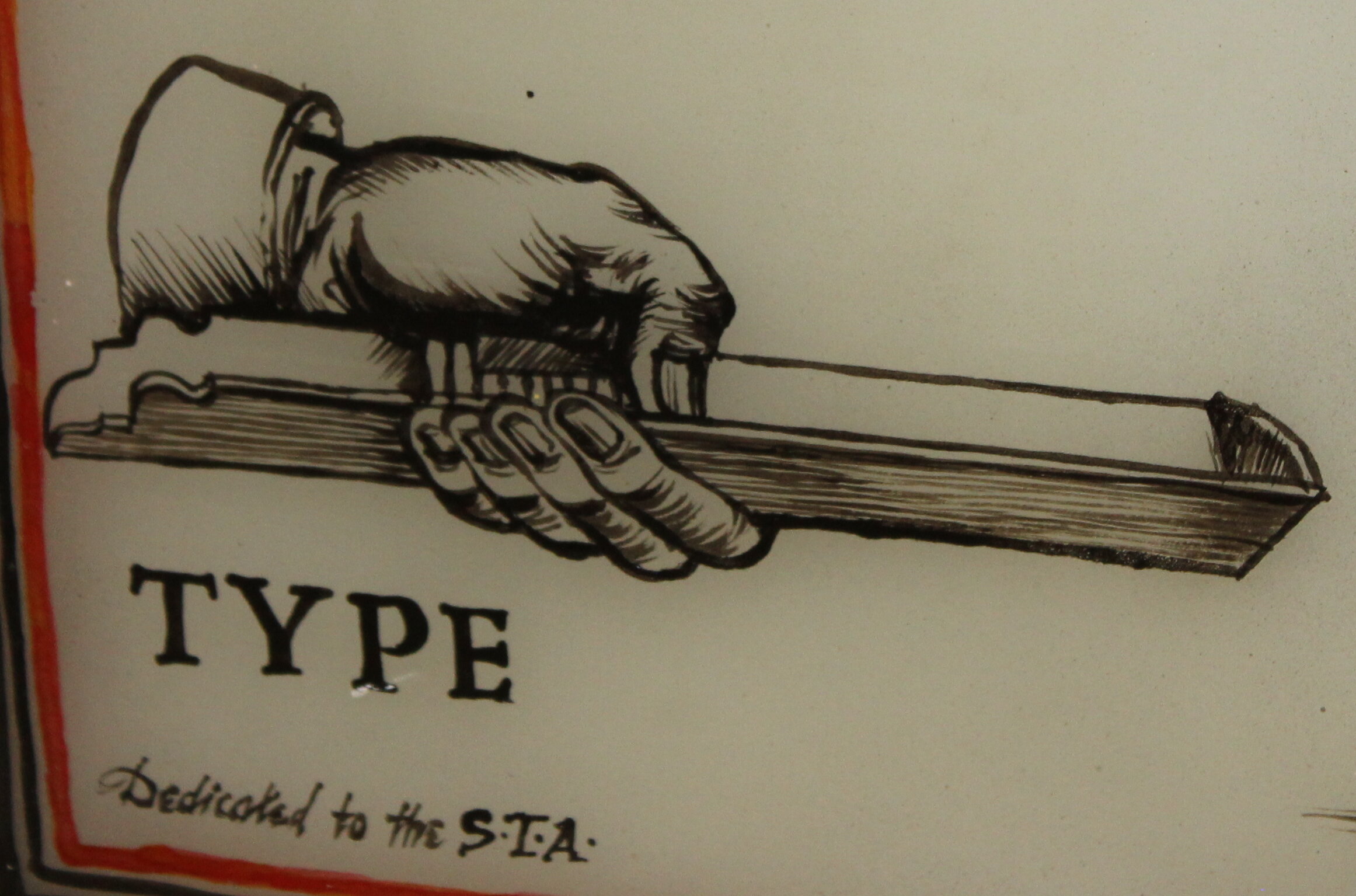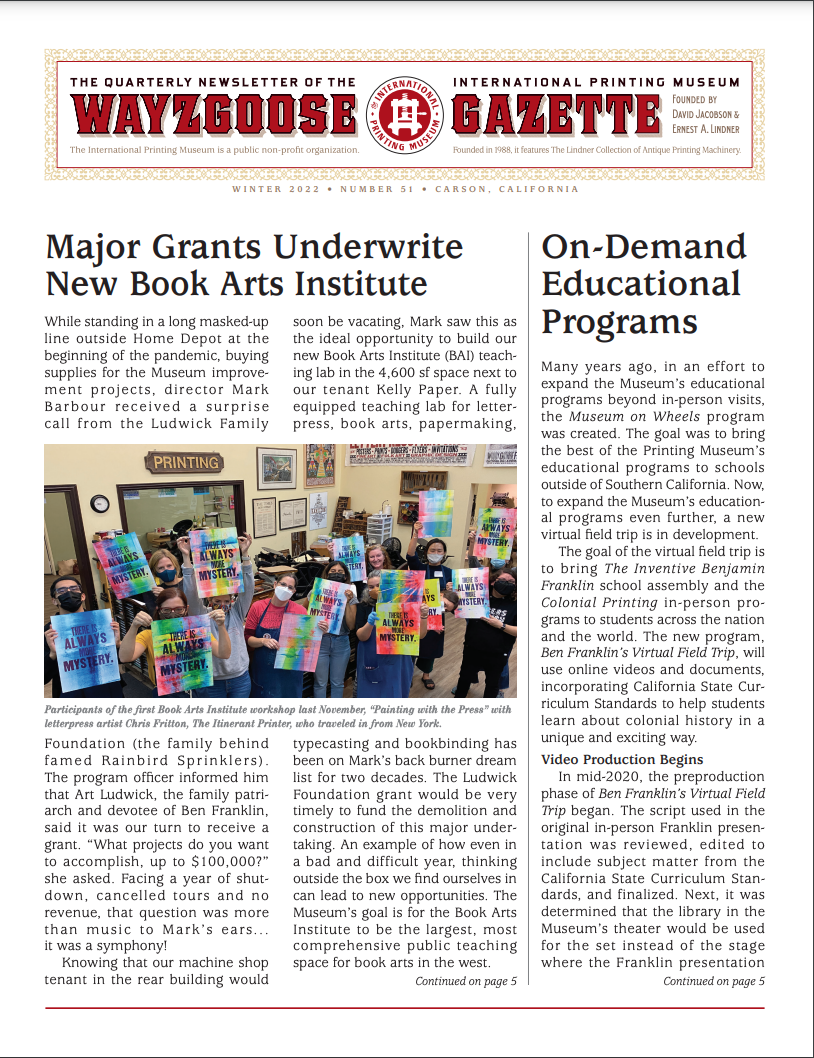NEW ARRIVALS AT THE PRINTING MUSEUM
/Part Two: “Lost” Edgar Miller Windows
The International Printing Museum curator, Mark Barbour, arrived in Los Angeles from Chicago with a truckload of antique printing presses and artifacts, only days before the state and national governments issued COVID19 stay-in-place orders. Among the donated items from Jerome Kosoglad in memory of his father a Chicago equipment dealer and collector, was a rare French stone lithographic press from 1870 with a printing stone used to print a famous Norman Rockwell edition. Also included was an 8’ wood type collage apparently created by an unknown Los Angeles artist (Santa Monica Blvd is spelled out in one part, as well as an image of the famous Los Angeles Ambassador Hotel).
And then there was the old crate with six carefully packed hand painted windows. Knowing next to nothing about the windows other than they depicted scenes from printing history and were hanging in Leonard Kosoglad’s private warehouse museum in Wheeling (Chicago) IL, since the 1980’s. Mark commented that the mystery of the windows intrigued him enough to give focus to the long truck drive across the country; only one of the windows was visible when the crate was loaded in Chicago and the images on the glass were stunning re-creations of early printing presses and famous printers.
Each window pane was carefully removed from the crate and set side by side in the Printing Museum gallery. We discovered each window was themed: Early Printing, Type, Papermaking, Lithography, Calligraphy, and Bookbinding. The images were taken from early books and illustrations, but the overall style of the painting and layout was distinctive. Mark began to look in detail at each glass panel for clues and information. Two of the panels had the signature of the artist, Edgar Miller, another had a date of 1961, and a third had a “Dedicated to The Society of Typographic Arts.” As the dust came off, the mystery of the windows slowly began to be revealed.
Our internet research uncovered wonderful details of this lesser known Chicago artist, designer and architect. Born in 1899 and dying in 1993, Edgar Miller was a superb and prolific graphic artist, designer, master craftsman of many disciplines but especially stained glass. Several innovative buildings he designed have survived, as well as interiors to many private homes, restaurants and buildings throughout Chicago. Because of his raw talent in so many artistic fields, Edgar Miller was given glowing contemporary descriptions of “the blond boy Michelangelo,” “a new luminary,” and “one of the most versatile artists in the America.”
We discovered the Edgar Miller Legacy, a Chicago non-profit, and contacted Zac Bleicher, Executive Director and Founder. Zac was elated that we had uncovered the “lost Edgar Miller windows.” Zac mentioned that they disappeared from their tracking some years ago. Our conversations filled in some important collaborating and missing details of the story.
Edgar Miller was a leader in the use of graphic art in advertising. His work included commissions from most of the leading printers and ad agencies in Chicago. He had a long relationship with many of the typographical masters of the time, explaining his connection to the Chicago-based Society of Typographic Arts, Chicago’s oldest professional design organization started in 1927, to whom he dedicated the windows.
The six windows were commissioned in the early 1950’s by Veritone Printing Company, a leading Chicago printer. They were completed by 1961, matching both the date on one window and the painting of a modern lithographic press from that same year. Each window highlights a different theme related to printing and graphic arts, from early and modern printing presses, bookbinding, early writing methods and typography. Edgar explained in a contemporary article that he used sign paint on sandblasted glass, a method which required him “to be careful about mistakes – NO ERASING! A true artist could easily disguise any ‘mistake’ by compensating from one line to the next. “
Following Veritone’s bankruptcy and liquidation in 1984, the windows ended up at IPEC Inc. in Wheeling, IL. Besides selling used printing equipment, Leonard Kosoglad of IPEC also maintained a small museum of printing at his warehouse. Leonard son, who followed him in the business, just donated these spectacular windows to The International Printing Museum, in Carson, along with the other remaining artifacts from his father’s museum, including the 1870 French Stone Lithographic Press.
We plan to have the windows up on display at the International Printing Museum shortly for our guests to enjoy. To Find Out More About Edgar Miller, please visit The Edgar Miller Legacy website. And if you ever visit Chicago and have time for a tour of the Edgar Miller House, Zac Bleicher will be an excellent guide for your discovery of this unsung American artist.
Click to zoom into the images below to take a closer look at the amazing details of these windows.










